Analyzing Leadership Styles' Impact on Employee Performance: A Report
VerifiedAdded on 2021/08/03
|30
|7069
|88
Report
AI Summary
This report examines the influence of leadership styles on employee performance, using Royal Garden Pvt. Ltd. as a case study. The research delves into various leadership theories, including contingency, situational, and behavioral theories, and explores different leadership styles such as transactional, transformational, laissez-faire, autocratic, and democratic. The study investigates the company's shift in management style, the resulting employee attitudes, and performance levels. The report provides a literature review of leadership styles and employee performance, and includes a discussion on the significance of the study, the research problems, questions, objectives, and chapter organization. The methodology chapter outlines the research framework, variables, population, data collection methods, and data representation. The subsequent chapters cover data analysis, presentation of findings, and recommendations, concluding with a discussion of the research's implications and potential extensions.
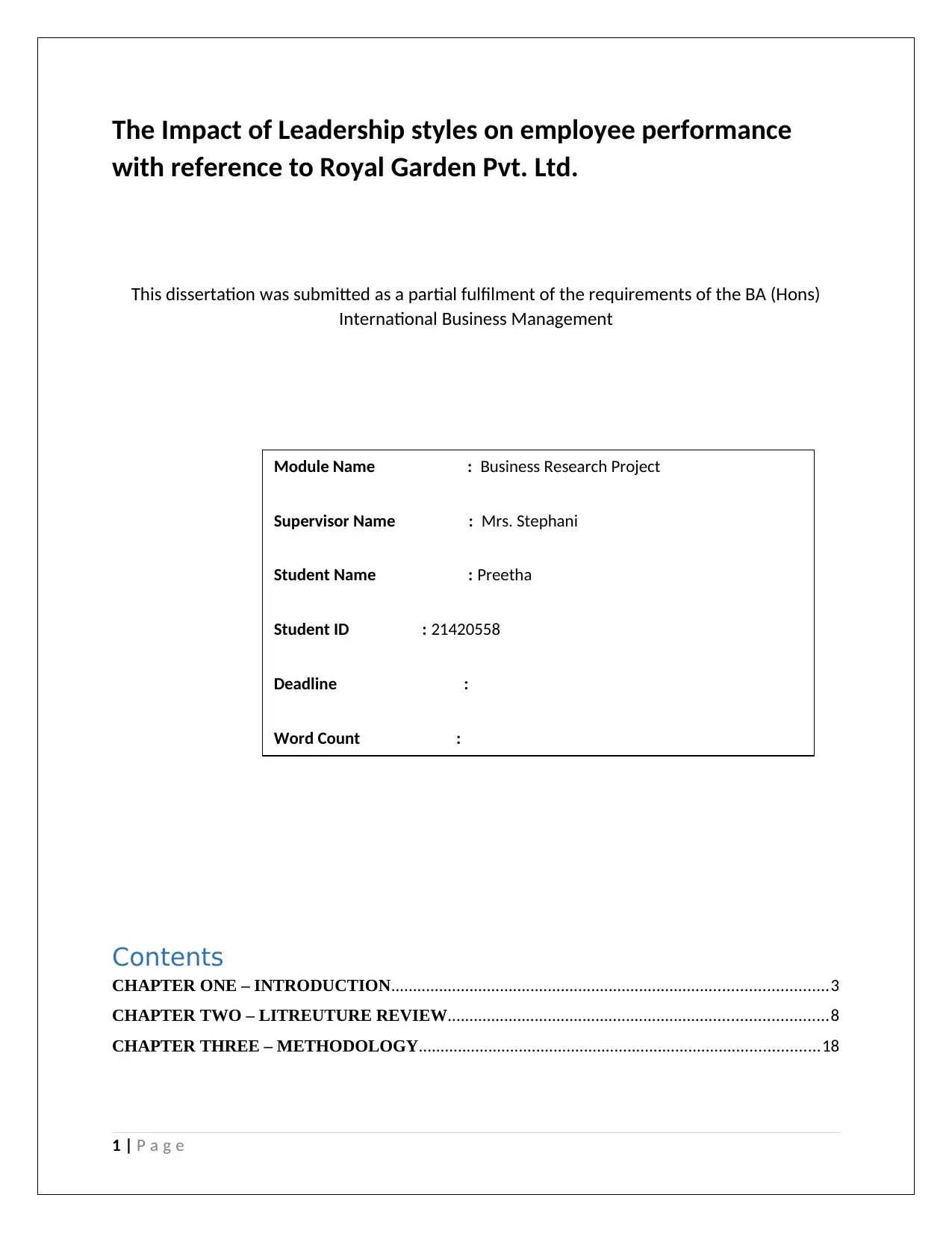
Module Name : Business Research Project
Supervisor Name : Mrs. Stephani
Student Name : Preetha
Student ID : 21420558
Deadline :
Word Count :
The Impact of Leadership styles on employee performance
with reference to Royal Garden Pvt. Ltd.
This dissertation was submitted as a partial fulfilment of the requirements of the BA (Hons)
International Business Management
Contents
CHAPTER ONE – INTRODUCTION....................................................................................................3
CHAPTER TWO – LITREUTURE REVIEW.......................................................................................8
CHAPTER THREE – METHODOLOGY............................................................................................18
1 | P a g e
Supervisor Name : Mrs. Stephani
Student Name : Preetha
Student ID : 21420558
Deadline :
Word Count :
The Impact of Leadership styles on employee performance
with reference to Royal Garden Pvt. Ltd.
This dissertation was submitted as a partial fulfilment of the requirements of the BA (Hons)
International Business Management
Contents
CHAPTER ONE – INTRODUCTION....................................................................................................3
CHAPTER TWO – LITREUTURE REVIEW.......................................................................................8
CHAPTER THREE – METHODOLOGY............................................................................................18
1 | P a g e
Paraphrase This Document
Need a fresh take? Get an instant paraphrase of this document with our AI Paraphraser
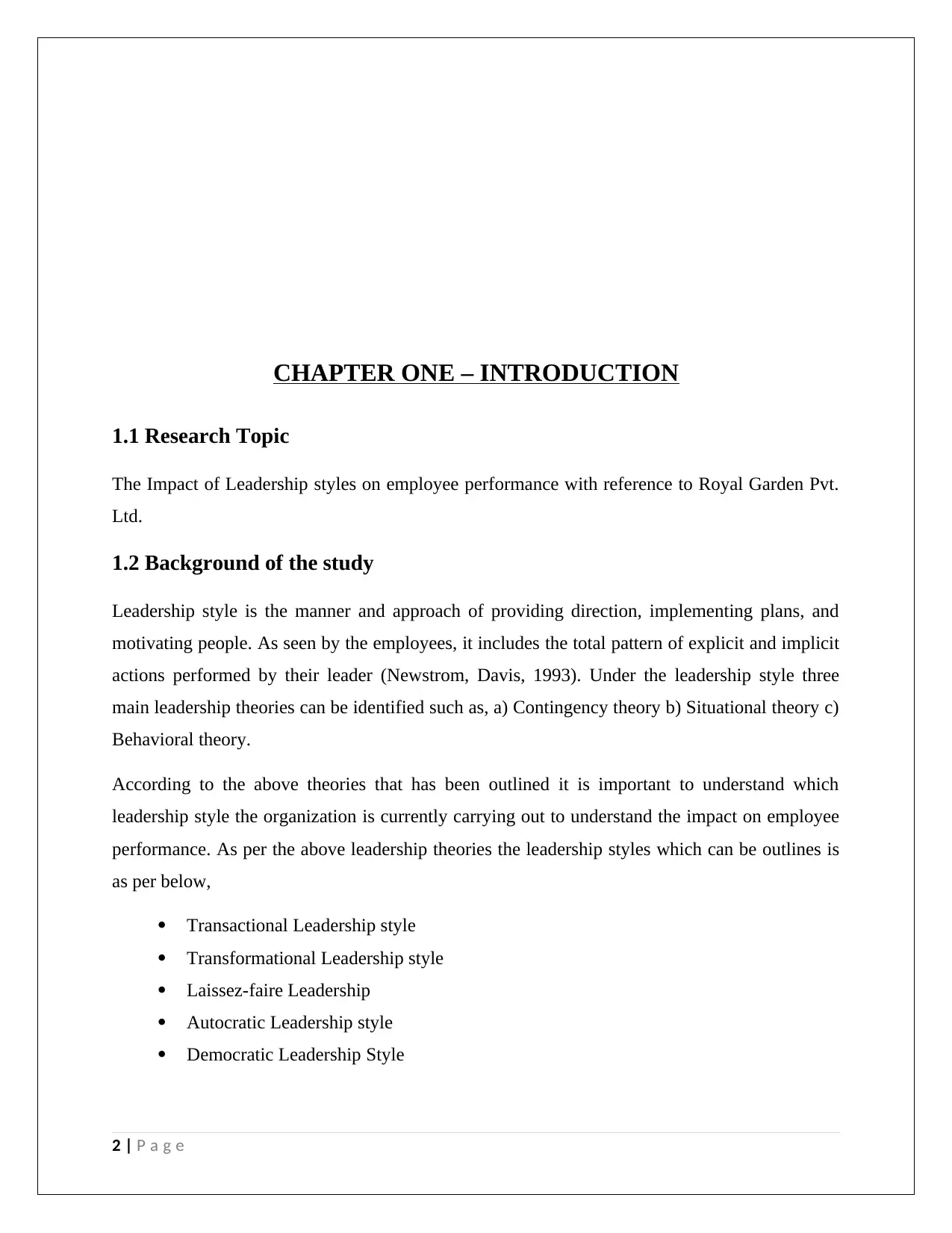
CHAPTER ONE – INTRODUCTION
1.1 Research Topic
The Impact of Leadership styles on employee performance with reference to Royal Garden Pvt.
Ltd.
1.2 Background of the study
Leadership style is the manner and approach of providing direction, implementing plans, and
motivating people. As seen by the employees, it includes the total pattern of explicit and implicit
actions performed by their leader (Newstrom, Davis, 1993). Under the leadership style three
main leadership theories can be identified such as, a) Contingency theory b) Situational theory c)
Behavioral theory.
According to the above theories that has been outlined it is important to understand which
leadership style the organization is currently carrying out to understand the impact on employee
performance. As per the above leadership theories the leadership styles which can be outlines is
as per below,
Transactional Leadership style
Transformational Leadership style
Laissez-faire Leadership
Autocratic Leadership style
Democratic Leadership Style
2 | P a g e
1.1 Research Topic
The Impact of Leadership styles on employee performance with reference to Royal Garden Pvt.
Ltd.
1.2 Background of the study
Leadership style is the manner and approach of providing direction, implementing plans, and
motivating people. As seen by the employees, it includes the total pattern of explicit and implicit
actions performed by their leader (Newstrom, Davis, 1993). Under the leadership style three
main leadership theories can be identified such as, a) Contingency theory b) Situational theory c)
Behavioral theory.
According to the above theories that has been outlined it is important to understand which
leadership style the organization is currently carrying out to understand the impact on employee
performance. As per the above leadership theories the leadership styles which can be outlines is
as per below,
Transactional Leadership style
Transformational Leadership style
Laissez-faire Leadership
Autocratic Leadership style
Democratic Leadership Style
2 | P a g e
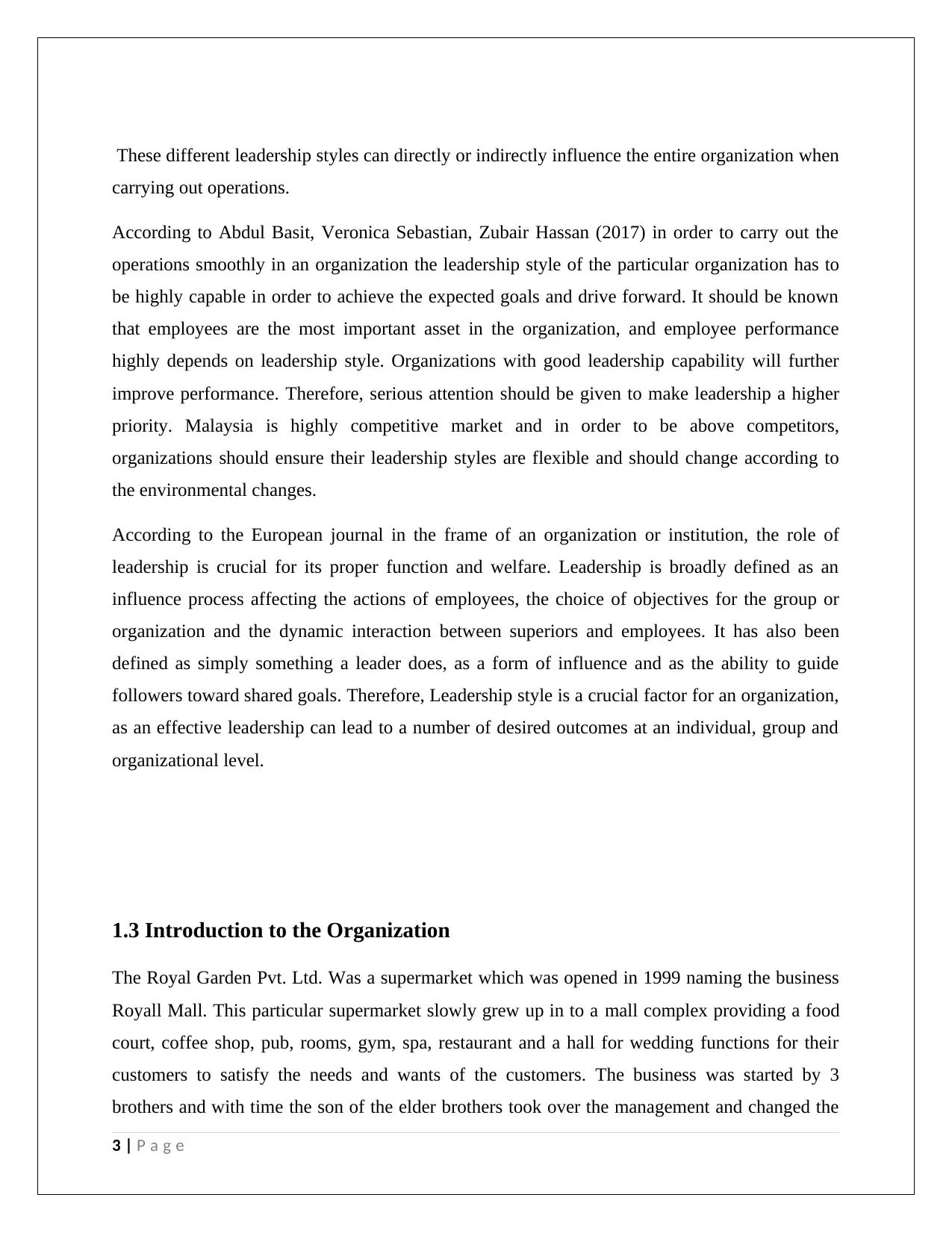
These different leadership styles can directly or indirectly influence the entire organization when
carrying out operations.
According to Abdul Basit, Veronica Sebastian, Zubair Hassan (2017) in order to carry out the
operations smoothly in an organization the leadership style of the particular organization has to
be highly capable in order to achieve the expected goals and drive forward. It should be known
that employees are the most important asset in the organization, and employee performance
highly depends on leadership style. Organizations with good leadership capability will further
improve performance. Therefore, serious attention should be given to make leadership a higher
priority. Malaysia is highly competitive market and in order to be above competitors,
organizations should ensure their leadership styles are flexible and should change according to
the environmental changes.
According to the European journal in the frame of an organization or institution, the role of
leadership is crucial for its proper function and welfare. Leadership is broadly defined as an
influence process affecting the actions of employees, the choice of objectives for the group or
organization and the dynamic interaction between superiors and employees. It has also been
defined as simply something a leader does, as a form of influence and as the ability to guide
followers toward shared goals. Therefore, Leadership style is a crucial factor for an organization,
as an effective leadership can lead to a number of desired outcomes at an individual, group and
organizational level.
1.3 Introduction to the Organization
The Royal Garden Pvt. Ltd. Was a supermarket which was opened in 1999 naming the business
Royall Mall. This particular supermarket slowly grew up in to a mall complex providing a food
court, coffee shop, pub, rooms, gym, spa, restaurant and a hall for wedding functions for their
customers to satisfy the needs and wants of the customers. The business was started by 3
brothers and with time the son of the elder brothers took over the management and changed the
3 | P a g e
carrying out operations.
According to Abdul Basit, Veronica Sebastian, Zubair Hassan (2017) in order to carry out the
operations smoothly in an organization the leadership style of the particular organization has to
be highly capable in order to achieve the expected goals and drive forward. It should be known
that employees are the most important asset in the organization, and employee performance
highly depends on leadership style. Organizations with good leadership capability will further
improve performance. Therefore, serious attention should be given to make leadership a higher
priority. Malaysia is highly competitive market and in order to be above competitors,
organizations should ensure their leadership styles are flexible and should change according to
the environmental changes.
According to the European journal in the frame of an organization or institution, the role of
leadership is crucial for its proper function and welfare. Leadership is broadly defined as an
influence process affecting the actions of employees, the choice of objectives for the group or
organization and the dynamic interaction between superiors and employees. It has also been
defined as simply something a leader does, as a form of influence and as the ability to guide
followers toward shared goals. Therefore, Leadership style is a crucial factor for an organization,
as an effective leadership can lead to a number of desired outcomes at an individual, group and
organizational level.
1.3 Introduction to the Organization
The Royal Garden Pvt. Ltd. Was a supermarket which was opened in 1999 naming the business
Royall Mall. This particular supermarket slowly grew up in to a mall complex providing a food
court, coffee shop, pub, rooms, gym, spa, restaurant and a hall for wedding functions for their
customers to satisfy the needs and wants of the customers. The business was started by 3
brothers and with time the son of the elder brothers took over the management and changed the
3 | P a g e
⊘ This is a preview!⊘
Do you want full access?
Subscribe today to unlock all pages.

Trusted by 1+ million students worldwide
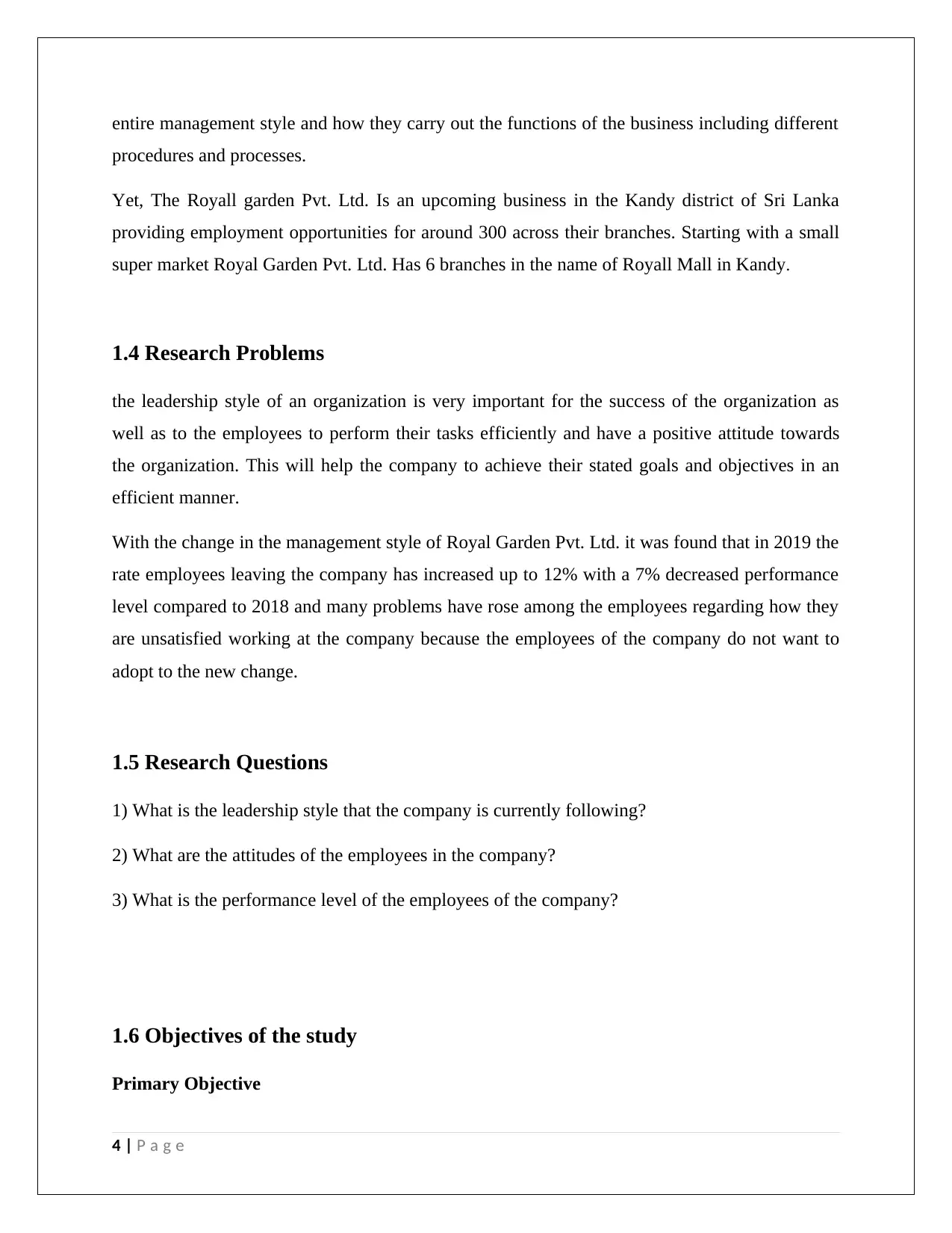
entire management style and how they carry out the functions of the business including different
procedures and processes.
Yet, The Royall garden Pvt. Ltd. Is an upcoming business in the Kandy district of Sri Lanka
providing employment opportunities for around 300 across their branches. Starting with a small
super market Royal Garden Pvt. Ltd. Has 6 branches in the name of Royall Mall in Kandy.
1.4 Research Problems
the leadership style of an organization is very important for the success of the organization as
well as to the employees to perform their tasks efficiently and have a positive attitude towards
the organization. This will help the company to achieve their stated goals and objectives in an
efficient manner.
With the change in the management style of Royal Garden Pvt. Ltd. it was found that in 2019 the
rate employees leaving the company has increased up to 12% with a 7% decreased performance
level compared to 2018 and many problems have rose among the employees regarding how they
are unsatisfied working at the company because the employees of the company do not want to
adopt to the new change.
1.5 Research Questions
1) What is the leadership style that the company is currently following?
2) What are the attitudes of the employees in the company?
3) What is the performance level of the employees of the company?
1.6 Objectives of the study
Primary Objective
4 | P a g e
procedures and processes.
Yet, The Royall garden Pvt. Ltd. Is an upcoming business in the Kandy district of Sri Lanka
providing employment opportunities for around 300 across their branches. Starting with a small
super market Royal Garden Pvt. Ltd. Has 6 branches in the name of Royall Mall in Kandy.
1.4 Research Problems
the leadership style of an organization is very important for the success of the organization as
well as to the employees to perform their tasks efficiently and have a positive attitude towards
the organization. This will help the company to achieve their stated goals and objectives in an
efficient manner.
With the change in the management style of Royal Garden Pvt. Ltd. it was found that in 2019 the
rate employees leaving the company has increased up to 12% with a 7% decreased performance
level compared to 2018 and many problems have rose among the employees regarding how they
are unsatisfied working at the company because the employees of the company do not want to
adopt to the new change.
1.5 Research Questions
1) What is the leadership style that the company is currently following?
2) What are the attitudes of the employees in the company?
3) What is the performance level of the employees of the company?
1.6 Objectives of the study
Primary Objective
4 | P a g e
Paraphrase This Document
Need a fresh take? Get an instant paraphrase of this document with our AI Paraphraser
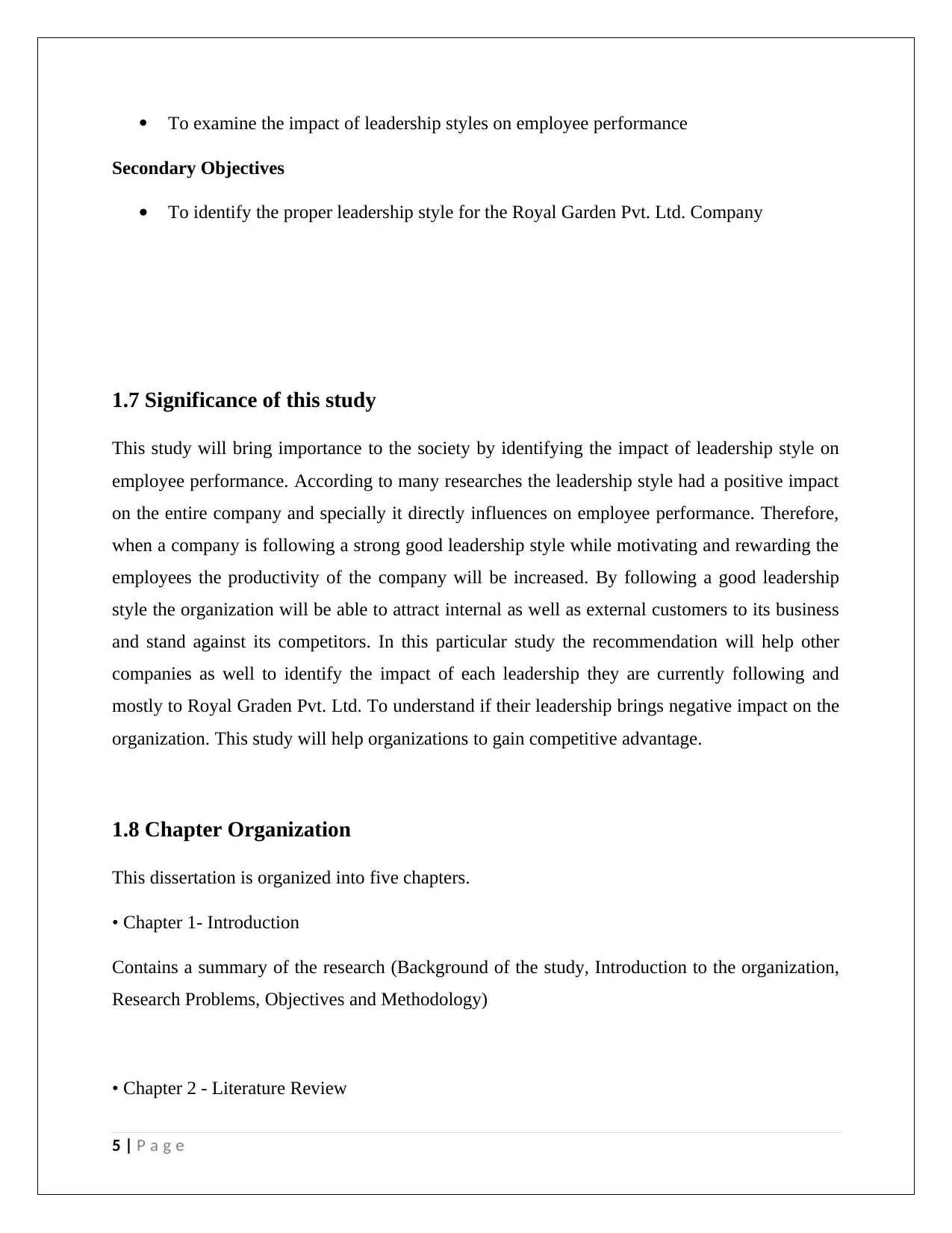
To examine the impact of leadership styles on employee performance
Secondary Objectives
To identify the proper leadership style for the Royal Garden Pvt. Ltd. Company
1.7 Significance of this study
This study will bring importance to the society by identifying the impact of leadership style on
employee performance. According to many researches the leadership style had a positive impact
on the entire company and specially it directly influences on employee performance. Therefore,
when a company is following a strong good leadership style while motivating and rewarding the
employees the productivity of the company will be increased. By following a good leadership
style the organization will be able to attract internal as well as external customers to its business
and stand against its competitors. In this particular study the recommendation will help other
companies as well to identify the impact of each leadership they are currently following and
mostly to Royal Graden Pvt. Ltd. To understand if their leadership brings negative impact on the
organization. This study will help organizations to gain competitive advantage.
1.8 Chapter Organization
This dissertation is organized into five chapters.
• Chapter 1- Introduction
Contains a summary of the research (Background of the study, Introduction to the organization,
Research Problems, Objectives and Methodology)
• Chapter 2 - Literature Review
5 | P a g e
Secondary Objectives
To identify the proper leadership style for the Royal Garden Pvt. Ltd. Company
1.7 Significance of this study
This study will bring importance to the society by identifying the impact of leadership style on
employee performance. According to many researches the leadership style had a positive impact
on the entire company and specially it directly influences on employee performance. Therefore,
when a company is following a strong good leadership style while motivating and rewarding the
employees the productivity of the company will be increased. By following a good leadership
style the organization will be able to attract internal as well as external customers to its business
and stand against its competitors. In this particular study the recommendation will help other
companies as well to identify the impact of each leadership they are currently following and
mostly to Royal Graden Pvt. Ltd. To understand if their leadership brings negative impact on the
organization. This study will help organizations to gain competitive advantage.
1.8 Chapter Organization
This dissertation is organized into five chapters.
• Chapter 1- Introduction
Contains a summary of the research (Background of the study, Introduction to the organization,
Research Problems, Objectives and Methodology)
• Chapter 2 - Literature Review
5 | P a g e
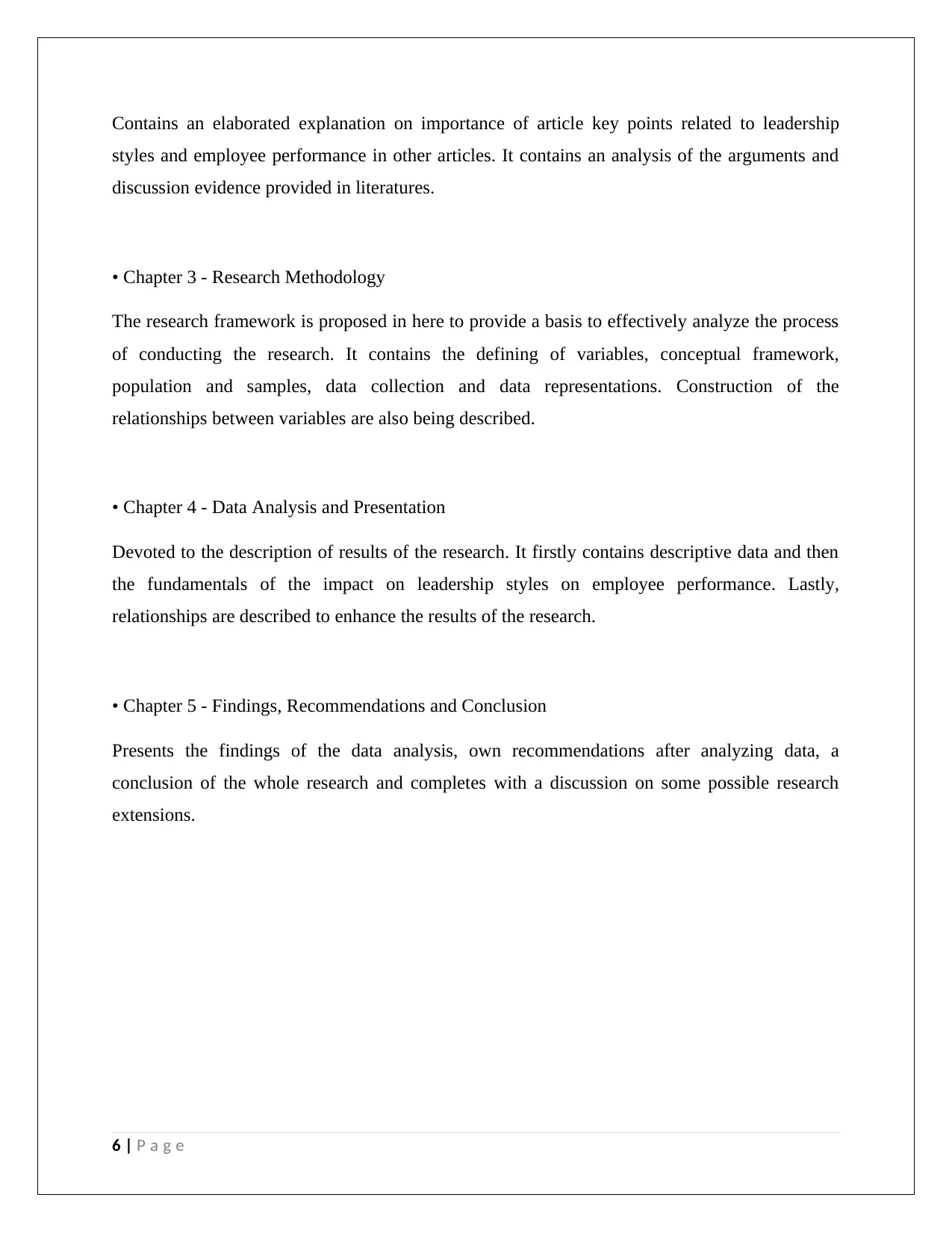
Contains an elaborated explanation on importance of article key points related to leadership
styles and employee performance in other articles. It contains an analysis of the arguments and
discussion evidence provided in literatures.
• Chapter 3 - Research Methodology
The research framework is proposed in here to provide a basis to effectively analyze the process
of conducting the research. It contains the defining of variables, conceptual framework,
population and samples, data collection and data representations. Construction of the
relationships between variables are also being described.
• Chapter 4 - Data Analysis and Presentation
Devoted to the description of results of the research. It firstly contains descriptive data and then
the fundamentals of the impact on leadership styles on employee performance. Lastly,
relationships are described to enhance the results of the research.
• Chapter 5 - Findings, Recommendations and Conclusion
Presents the findings of the data analysis, own recommendations after analyzing data, a
conclusion of the whole research and completes with a discussion on some possible research
extensions.
6 | P a g e
styles and employee performance in other articles. It contains an analysis of the arguments and
discussion evidence provided in literatures.
• Chapter 3 - Research Methodology
The research framework is proposed in here to provide a basis to effectively analyze the process
of conducting the research. It contains the defining of variables, conceptual framework,
population and samples, data collection and data representations. Construction of the
relationships between variables are also being described.
• Chapter 4 - Data Analysis and Presentation
Devoted to the description of results of the research. It firstly contains descriptive data and then
the fundamentals of the impact on leadership styles on employee performance. Lastly,
relationships are described to enhance the results of the research.
• Chapter 5 - Findings, Recommendations and Conclusion
Presents the findings of the data analysis, own recommendations after analyzing data, a
conclusion of the whole research and completes with a discussion on some possible research
extensions.
6 | P a g e
⊘ This is a preview!⊘
Do you want full access?
Subscribe today to unlock all pages.

Trusted by 1+ million students worldwide
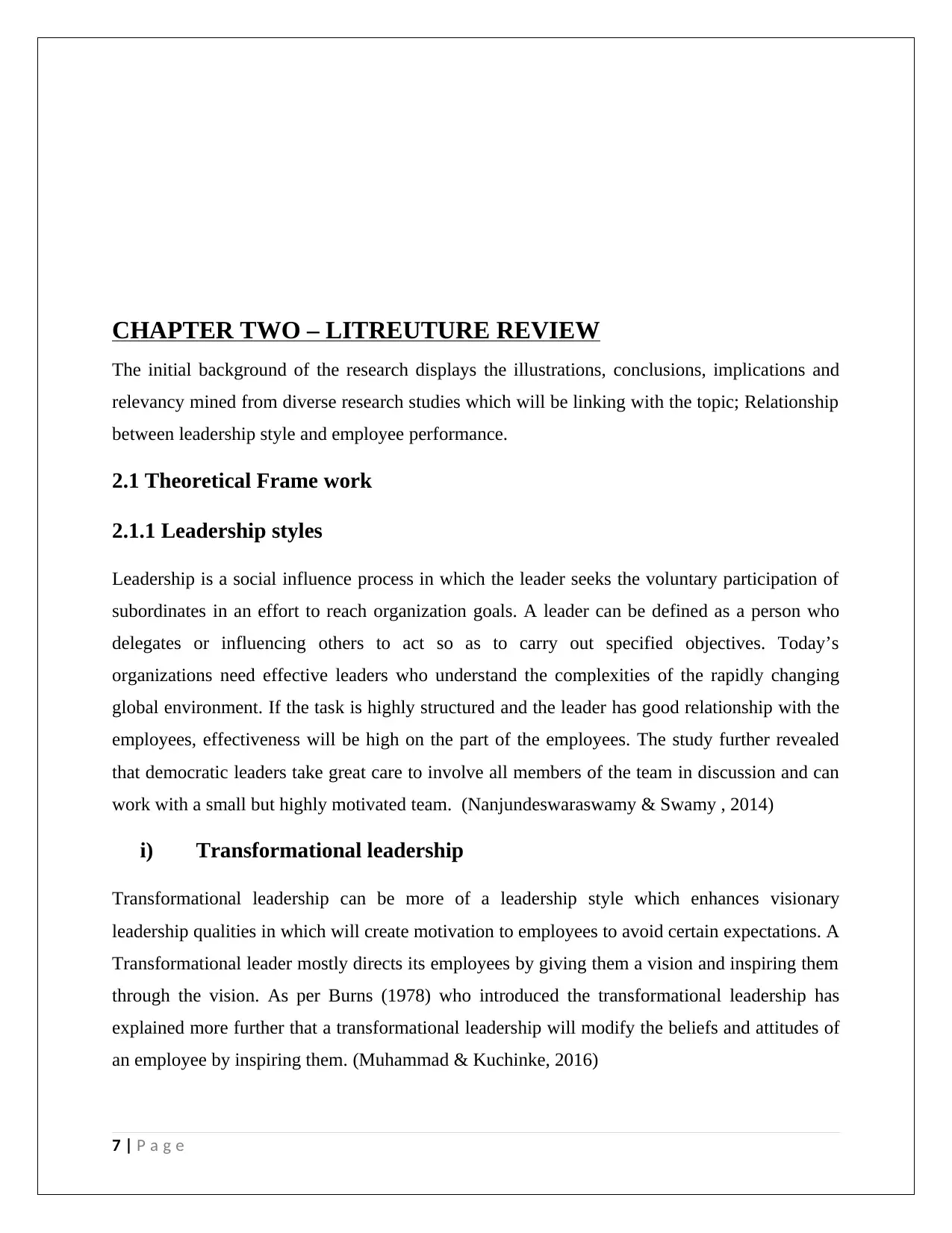
CHAPTER TWO – LITREUTURE REVIEW
The initial background of the research displays the illustrations, conclusions, implications and
relevancy mined from diverse research studies which will be linking with the topic; Relationship
between leadership style and employee performance.
2.1 Theoretical Frame work
2.1.1 Leadership styles
Leadership is a social influence process in which the leader seeks the voluntary participation of
subordinates in an effort to reach organization goals. A leader can be defined as a person who
delegates or influencing others to act so as to carry out specified objectives. Today’s
organizations need effective leaders who understand the complexities of the rapidly changing
global environment. If the task is highly structured and the leader has good relationship with the
employees, effectiveness will be high on the part of the employees. The study further revealed
that democratic leaders take great care to involve all members of the team in discussion and can
work with a small but highly motivated team. (Nanjundeswaraswamy & Swamy , 2014)
i) Transformational leadership
Transformational leadership can be more of a leadership style which enhances visionary
leadership qualities in which will create motivation to employees to avoid certain expectations. A
Transformational leader mostly directs its employees by giving them a vision and inspiring them
through the vision. As per Burns (1978) who introduced the transformational leadership has
explained more further that a transformational leadership will modify the beliefs and attitudes of
an employee by inspiring them. (Muhammad & Kuchinke, 2016)
7 | P a g e
The initial background of the research displays the illustrations, conclusions, implications and
relevancy mined from diverse research studies which will be linking with the topic; Relationship
between leadership style and employee performance.
2.1 Theoretical Frame work
2.1.1 Leadership styles
Leadership is a social influence process in which the leader seeks the voluntary participation of
subordinates in an effort to reach organization goals. A leader can be defined as a person who
delegates or influencing others to act so as to carry out specified objectives. Today’s
organizations need effective leaders who understand the complexities of the rapidly changing
global environment. If the task is highly structured and the leader has good relationship with the
employees, effectiveness will be high on the part of the employees. The study further revealed
that democratic leaders take great care to involve all members of the team in discussion and can
work with a small but highly motivated team. (Nanjundeswaraswamy & Swamy , 2014)
i) Transformational leadership
Transformational leadership can be more of a leadership style which enhances visionary
leadership qualities in which will create motivation to employees to avoid certain expectations. A
Transformational leader mostly directs its employees by giving them a vision and inspiring them
through the vision. As per Burns (1978) who introduced the transformational leadership has
explained more further that a transformational leadership will modify the beliefs and attitudes of
an employee by inspiring them. (Muhammad & Kuchinke, 2016)
7 | P a g e
Paraphrase This Document
Need a fresh take? Get an instant paraphrase of this document with our AI Paraphraser
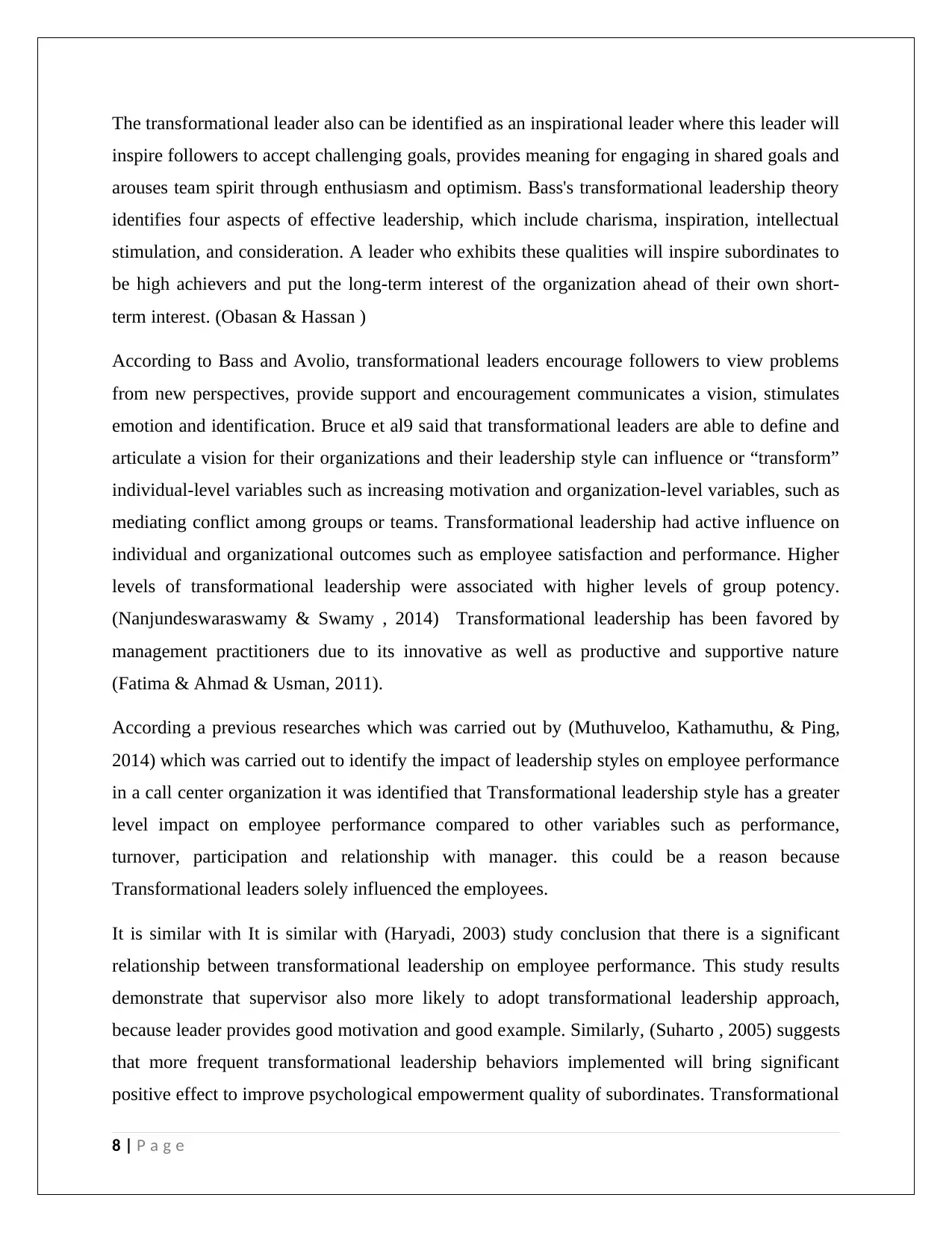
The transformational leader also can be identified as an inspirational leader where this leader will
inspire followers to accept challenging goals, provides meaning for engaging in shared goals and
arouses team spirit through enthusiasm and optimism. Bass's transformational leadership theory
identifies four aspects of effective leadership, which include charisma, inspiration, intellectual
stimulation, and consideration. A leader who exhibits these qualities will inspire subordinates to
be high achievers and put the long-term interest of the organization ahead of their own short-
term interest. (Obasan & Hassan )
According to Bass and Avolio, transformational leaders encourage followers to view problems
from new perspectives, provide support and encouragement communicates a vision, stimulates
emotion and identification. Bruce et al9 said that transformational leaders are able to define and
articulate a vision for their organizations and their leadership style can influence or “transform”
individual-level variables such as increasing motivation and organization-level variables, such as
mediating conflict among groups or teams. Transformational leadership had active influence on
individual and organizational outcomes such as employee satisfaction and performance. Higher
levels of transformational leadership were associated with higher levels of group potency.
(Nanjundeswaraswamy & Swamy , 2014) Transformational leadership has been favored by
management practitioners due to its innovative as well as productive and supportive nature
(Fatima & Ahmad & Usman, 2011).
According a previous researches which was carried out by (Muthuveloo, Kathamuthu, & Ping,
2014) which was carried out to identify the impact of leadership styles on employee performance
in a call center organization it was identified that Transformational leadership style has a greater
level impact on employee performance compared to other variables such as performance,
turnover, participation and relationship with manager. this could be a reason because
Transformational leaders solely influenced the employees.
It is similar with It is similar with (Haryadi, 2003) study conclusion that there is a significant
relationship between transformational leadership on employee performance. This study results
demonstrate that supervisor also more likely to adopt transformational leadership approach,
because leader provides good motivation and good example. Similarly, (Suharto , 2005) suggests
that more frequent transformational leadership behaviors implemented will bring significant
positive effect to improve psychological empowerment quality of subordinates. Transformational
8 | P a g e
inspire followers to accept challenging goals, provides meaning for engaging in shared goals and
arouses team spirit through enthusiasm and optimism. Bass's transformational leadership theory
identifies four aspects of effective leadership, which include charisma, inspiration, intellectual
stimulation, and consideration. A leader who exhibits these qualities will inspire subordinates to
be high achievers and put the long-term interest of the organization ahead of their own short-
term interest. (Obasan & Hassan )
According to Bass and Avolio, transformational leaders encourage followers to view problems
from new perspectives, provide support and encouragement communicates a vision, stimulates
emotion and identification. Bruce et al9 said that transformational leaders are able to define and
articulate a vision for their organizations and their leadership style can influence or “transform”
individual-level variables such as increasing motivation and organization-level variables, such as
mediating conflict among groups or teams. Transformational leadership had active influence on
individual and organizational outcomes such as employee satisfaction and performance. Higher
levels of transformational leadership were associated with higher levels of group potency.
(Nanjundeswaraswamy & Swamy , 2014) Transformational leadership has been favored by
management practitioners due to its innovative as well as productive and supportive nature
(Fatima & Ahmad & Usman, 2011).
According a previous researches which was carried out by (Muthuveloo, Kathamuthu, & Ping,
2014) which was carried out to identify the impact of leadership styles on employee performance
in a call center organization it was identified that Transformational leadership style has a greater
level impact on employee performance compared to other variables such as performance,
turnover, participation and relationship with manager. this could be a reason because
Transformational leaders solely influenced the employees.
It is similar with It is similar with (Haryadi, 2003) study conclusion that there is a significant
relationship between transformational leadership on employee performance. This study results
demonstrate that supervisor also more likely to adopt transformational leadership approach,
because leader provides good motivation and good example. Similarly, (Suharto , 2005) suggests
that more frequent transformational leadership behaviors implemented will bring significant
positive effect to improve psychological empowerment quality of subordinates. Transformational
8 | P a g e
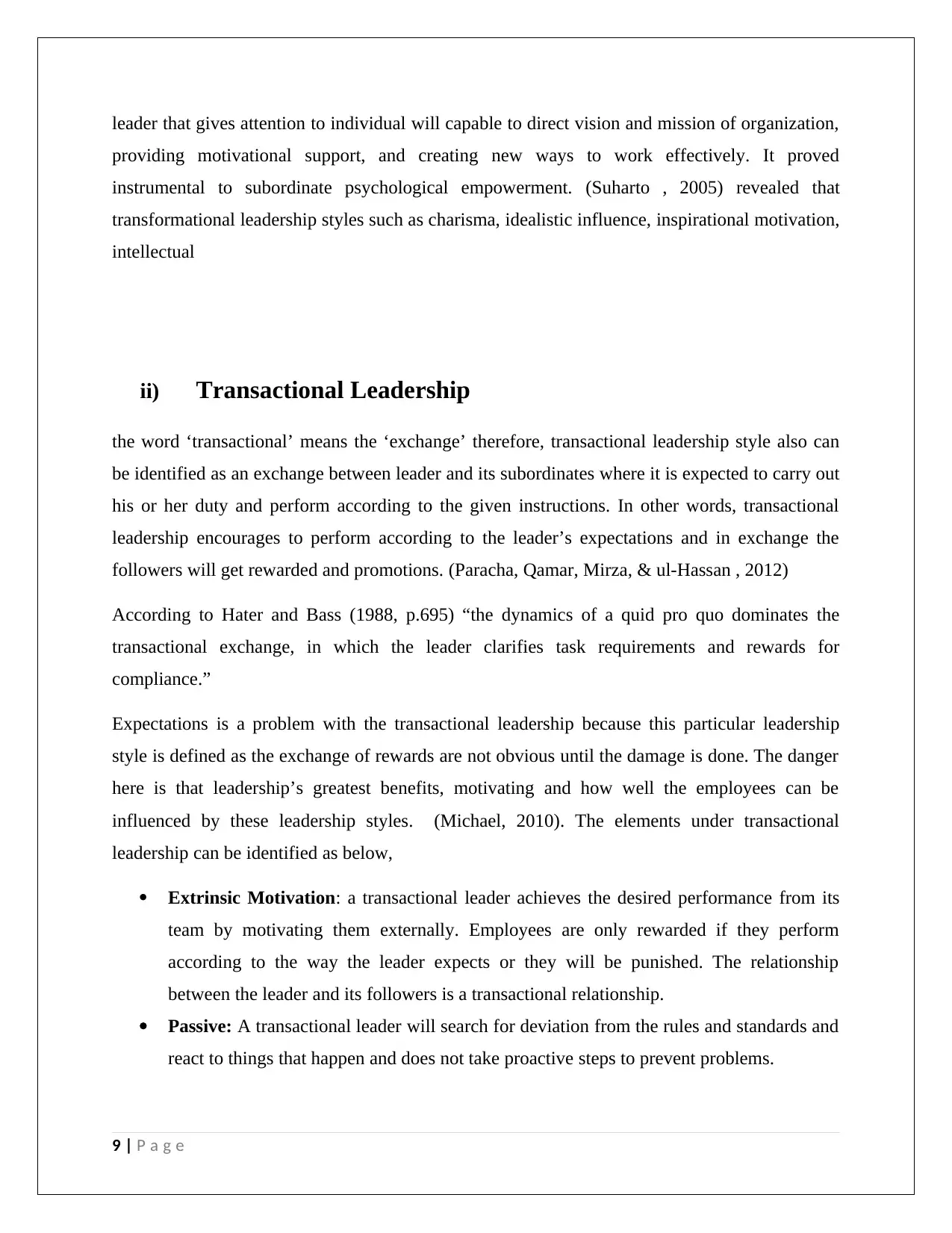
leader that gives attention to individual will capable to direct vision and mission of organization,
providing motivational support, and creating new ways to work effectively. It proved
instrumental to subordinate psychological empowerment. (Suharto , 2005) revealed that
transformational leadership styles such as charisma, idealistic influence, inspirational motivation,
intellectual
ii) Transactional Leadership
the word ‘transactional’ means the ‘exchange’ therefore, transactional leadership style also can
be identified as an exchange between leader and its subordinates where it is expected to carry out
his or her duty and perform according to the given instructions. In other words, transactional
leadership encourages to perform according to the leader’s expectations and in exchange the
followers will get rewarded and promotions. (Paracha, Qamar, Mirza, & ul-Hassan , 2012)
According to Hater and Bass (1988, p.695) “the dynamics of a quid pro quo dominates the
transactional exchange, in which the leader clarifies task requirements and rewards for
compliance.”
Expectations is a problem with the transactional leadership because this particular leadership
style is defined as the exchange of rewards are not obvious until the damage is done. The danger
here is that leadership’s greatest benefits, motivating and how well the employees can be
influenced by these leadership styles. (Michael, 2010). The elements under transactional
leadership can be identified as below,
Extrinsic Motivation: a transactional leader achieves the desired performance from its
team by motivating them externally. Employees are only rewarded if they perform
according to the way the leader expects or they will be punished. The relationship
between the leader and its followers is a transactional relationship.
Passive: A transactional leader will search for deviation from the rules and standards and
react to things that happen and does not take proactive steps to prevent problems.
9 | P a g e
providing motivational support, and creating new ways to work effectively. It proved
instrumental to subordinate psychological empowerment. (Suharto , 2005) revealed that
transformational leadership styles such as charisma, idealistic influence, inspirational motivation,
intellectual
ii) Transactional Leadership
the word ‘transactional’ means the ‘exchange’ therefore, transactional leadership style also can
be identified as an exchange between leader and its subordinates where it is expected to carry out
his or her duty and perform according to the given instructions. In other words, transactional
leadership encourages to perform according to the leader’s expectations and in exchange the
followers will get rewarded and promotions. (Paracha, Qamar, Mirza, & ul-Hassan , 2012)
According to Hater and Bass (1988, p.695) “the dynamics of a quid pro quo dominates the
transactional exchange, in which the leader clarifies task requirements and rewards for
compliance.”
Expectations is a problem with the transactional leadership because this particular leadership
style is defined as the exchange of rewards are not obvious until the damage is done. The danger
here is that leadership’s greatest benefits, motivating and how well the employees can be
influenced by these leadership styles. (Michael, 2010). The elements under transactional
leadership can be identified as below,
Extrinsic Motivation: a transactional leader achieves the desired performance from its
team by motivating them externally. Employees are only rewarded if they perform
according to the way the leader expects or they will be punished. The relationship
between the leader and its followers is a transactional relationship.
Passive: A transactional leader will search for deviation from the rules and standards and
react to things that happen and does not take proactive steps to prevent problems.
9 | P a g e
⊘ This is a preview!⊘
Do you want full access?
Subscribe today to unlock all pages.

Trusted by 1+ million students worldwide
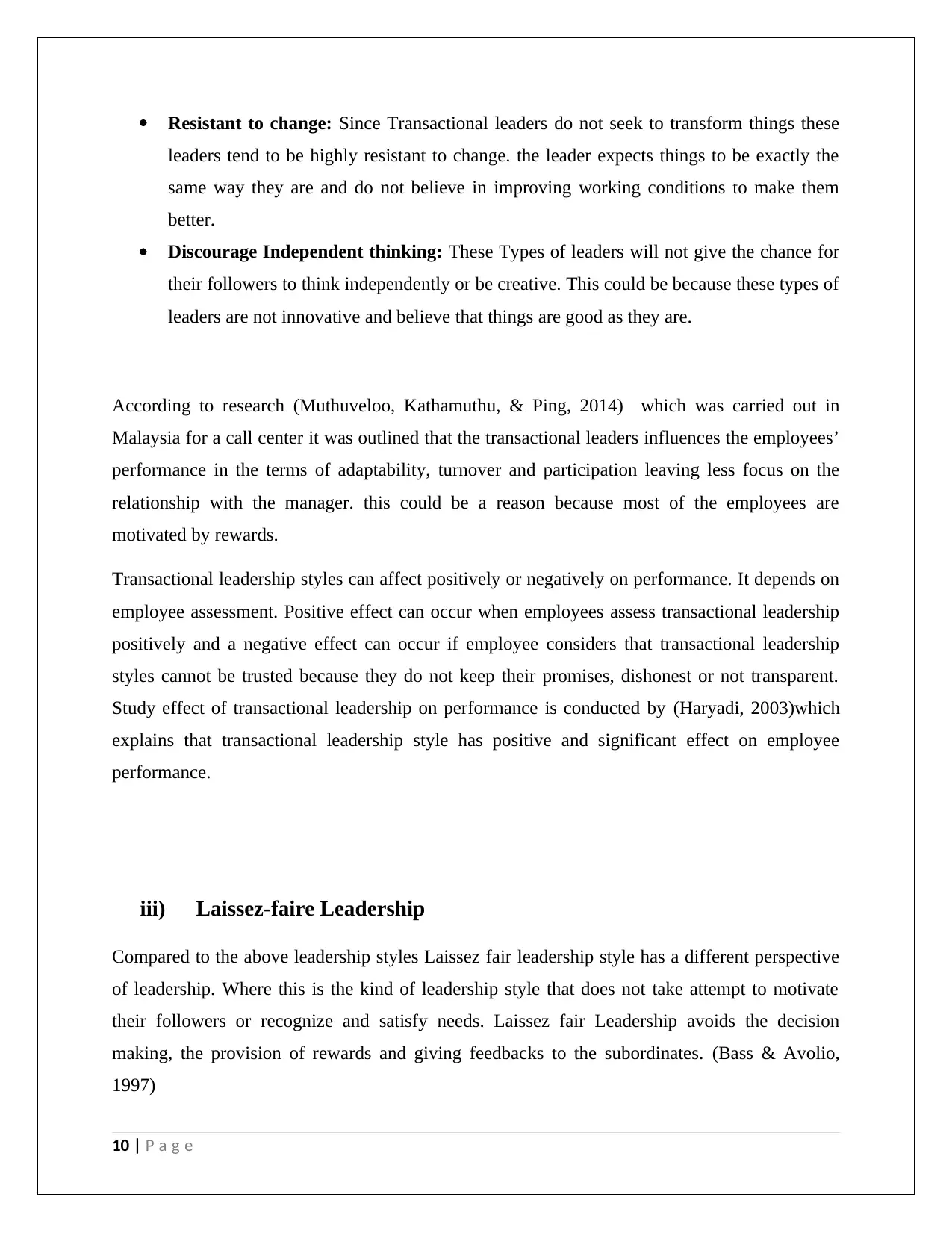
Resistant to change: Since Transactional leaders do not seek to transform things these
leaders tend to be highly resistant to change. the leader expects things to be exactly the
same way they are and do not believe in improving working conditions to make them
better.
Discourage Independent thinking: These Types of leaders will not give the chance for
their followers to think independently or be creative. This could be because these types of
leaders are not innovative and believe that things are good as they are.
According to research (Muthuveloo, Kathamuthu, & Ping, 2014) which was carried out in
Malaysia for a call center it was outlined that the transactional leaders influences the employees’
performance in the terms of adaptability, turnover and participation leaving less focus on the
relationship with the manager. this could be a reason because most of the employees are
motivated by rewards.
Transactional leadership styles can affect positively or negatively on performance. It depends on
employee assessment. Positive effect can occur when employees assess transactional leadership
positively and a negative effect can occur if employee considers that transactional leadership
styles cannot be trusted because they do not keep their promises, dishonest or not transparent.
Study effect of transactional leadership on performance is conducted by (Haryadi, 2003)which
explains that transactional leadership style has positive and significant effect on employee
performance.
iii) Laissez-faire Leadership
Compared to the above leadership styles Laissez fair leadership style has a different perspective
of leadership. Where this is the kind of leadership style that does not take attempt to motivate
their followers or recognize and satisfy needs. Laissez fair Leadership avoids the decision
making, the provision of rewards and giving feedbacks to the subordinates. (Bass & Avolio,
1997)
10 | P a g e
leaders tend to be highly resistant to change. the leader expects things to be exactly the
same way they are and do not believe in improving working conditions to make them
better.
Discourage Independent thinking: These Types of leaders will not give the chance for
their followers to think independently or be creative. This could be because these types of
leaders are not innovative and believe that things are good as they are.
According to research (Muthuveloo, Kathamuthu, & Ping, 2014) which was carried out in
Malaysia for a call center it was outlined that the transactional leaders influences the employees’
performance in the terms of adaptability, turnover and participation leaving less focus on the
relationship with the manager. this could be a reason because most of the employees are
motivated by rewards.
Transactional leadership styles can affect positively or negatively on performance. It depends on
employee assessment. Positive effect can occur when employees assess transactional leadership
positively and a negative effect can occur if employee considers that transactional leadership
styles cannot be trusted because they do not keep their promises, dishonest or not transparent.
Study effect of transactional leadership on performance is conducted by (Haryadi, 2003)which
explains that transactional leadership style has positive and significant effect on employee
performance.
iii) Laissez-faire Leadership
Compared to the above leadership styles Laissez fair leadership style has a different perspective
of leadership. Where this is the kind of leadership style that does not take attempt to motivate
their followers or recognize and satisfy needs. Laissez fair Leadership avoids the decision
making, the provision of rewards and giving feedbacks to the subordinates. (Bass & Avolio,
1997)
10 | P a g e
Paraphrase This Document
Need a fresh take? Get an instant paraphrase of this document with our AI Paraphraser
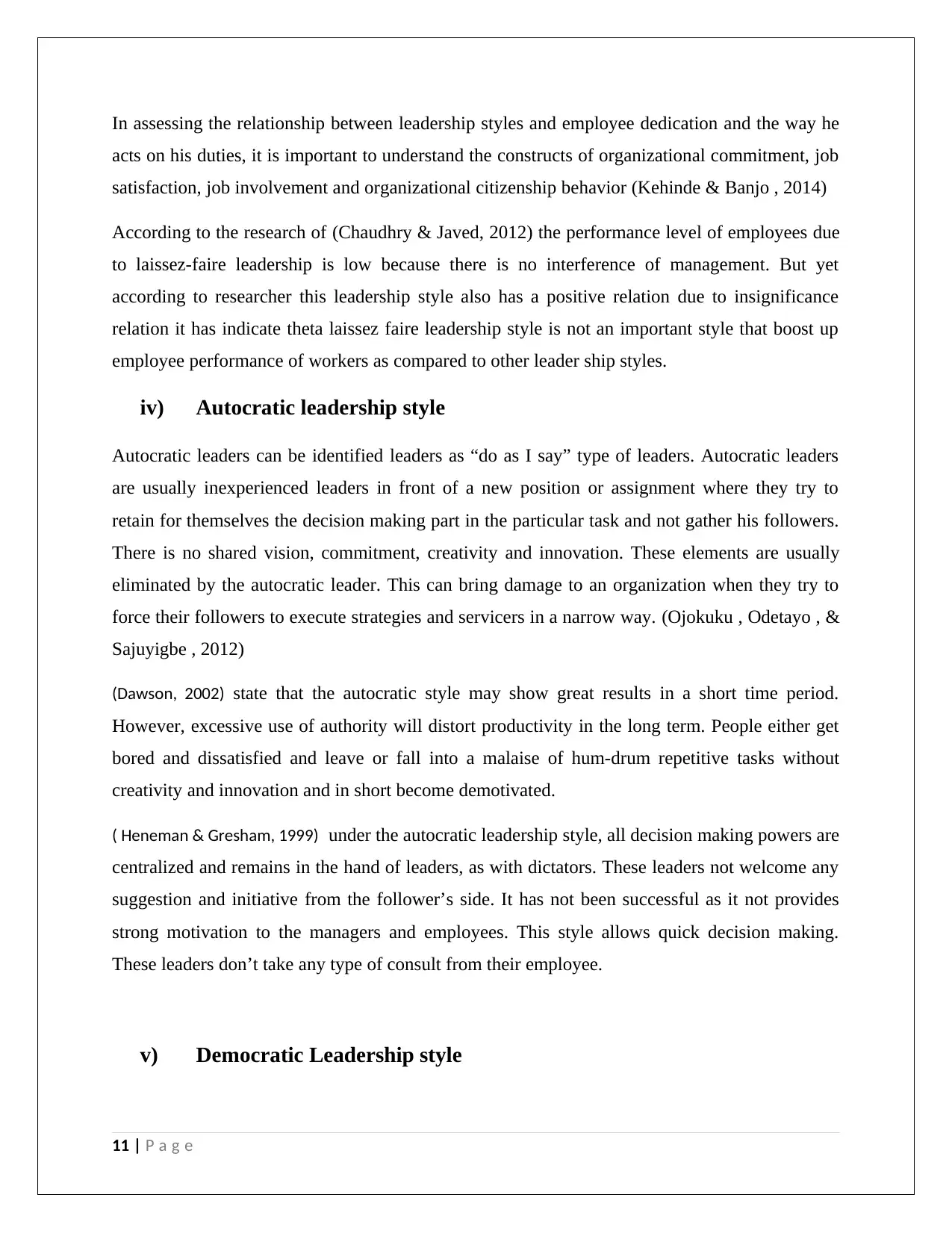
In assessing the relationship between leadership styles and employee dedication and the way he
acts on his duties, it is important to understand the constructs of organizational commitment, job
satisfaction, job involvement and organizational citizenship behavior (Kehinde & Banjo , 2014)
According to the research of (Chaudhry & Javed, 2012) the performance level of employees due
to laissez-faire leadership is low because there is no interference of management. But yet
according to researcher this leadership style also has a positive relation due to insignificance
relation it has indicate theta laissez faire leadership style is not an important style that boost up
employee performance of workers as compared to other leader ship styles.
iv) Autocratic leadership style
Autocratic leaders can be identified leaders as “do as I say” type of leaders. Autocratic leaders
are usually inexperienced leaders in front of a new position or assignment where they try to
retain for themselves the decision making part in the particular task and not gather his followers.
There is no shared vision, commitment, creativity and innovation. These elements are usually
eliminated by the autocratic leader. This can bring damage to an organization when they try to
force their followers to execute strategies and servicers in a narrow way. (Ojokuku , Odetayo , &
Sajuyigbe , 2012)
(Dawson, 2002) state that the autocratic style may show great results in a short time period.
However, excessive use of authority will distort productivity in the long term. People either get
bored and dissatisfied and leave or fall into a malaise of hum-drum repetitive tasks without
creativity and innovation and in short become demotivated.
( Heneman & Gresham, 1999) under the autocratic leadership style, all decision making powers are
centralized and remains in the hand of leaders, as with dictators. These leaders not welcome any
suggestion and initiative from the follower’s side. It has not been successful as it not provides
strong motivation to the managers and employees. This style allows quick decision making.
These leaders don’t take any type of consult from their employee.
v) Democratic Leadership style
11 | P a g e
acts on his duties, it is important to understand the constructs of organizational commitment, job
satisfaction, job involvement and organizational citizenship behavior (Kehinde & Banjo , 2014)
According to the research of (Chaudhry & Javed, 2012) the performance level of employees due
to laissez-faire leadership is low because there is no interference of management. But yet
according to researcher this leadership style also has a positive relation due to insignificance
relation it has indicate theta laissez faire leadership style is not an important style that boost up
employee performance of workers as compared to other leader ship styles.
iv) Autocratic leadership style
Autocratic leaders can be identified leaders as “do as I say” type of leaders. Autocratic leaders
are usually inexperienced leaders in front of a new position or assignment where they try to
retain for themselves the decision making part in the particular task and not gather his followers.
There is no shared vision, commitment, creativity and innovation. These elements are usually
eliminated by the autocratic leader. This can bring damage to an organization when they try to
force their followers to execute strategies and servicers in a narrow way. (Ojokuku , Odetayo , &
Sajuyigbe , 2012)
(Dawson, 2002) state that the autocratic style may show great results in a short time period.
However, excessive use of authority will distort productivity in the long term. People either get
bored and dissatisfied and leave or fall into a malaise of hum-drum repetitive tasks without
creativity and innovation and in short become demotivated.
( Heneman & Gresham, 1999) under the autocratic leadership style, all decision making powers are
centralized and remains in the hand of leaders, as with dictators. These leaders not welcome any
suggestion and initiative from the follower’s side. It has not been successful as it not provides
strong motivation to the managers and employees. This style allows quick decision making.
These leaders don’t take any type of consult from their employee.
v) Democratic Leadership style
11 | P a g e
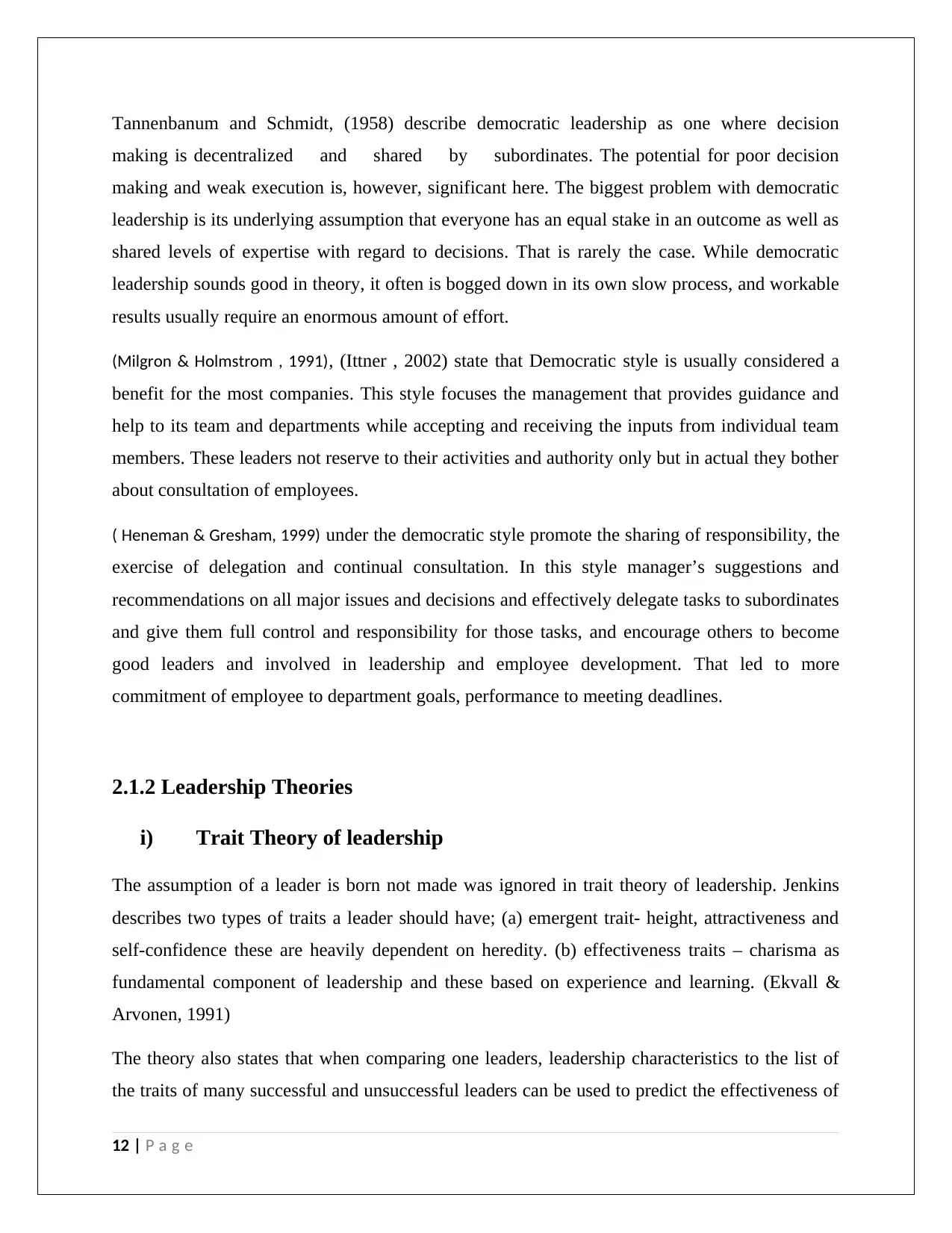
Tannenbanum and Schmidt, (1958) describe democratic leadership as one where decision
making is decentralized and shared by subordinates. The potential for poor decision
making and weak execution is, however, significant here. The biggest problem with democratic
leadership is its underlying assumption that everyone has an equal stake in an outcome as well as
shared levels of expertise with regard to decisions. That is rarely the case. While democratic
leadership sounds good in theory, it often is bogged down in its own slow process, and workable
results usually require an enormous amount of effort.
(Milgron & Holmstrom , 1991), (Ittner , 2002) state that Democratic style is usually considered a
benefit for the most companies. This style focuses the management that provides guidance and
help to its team and departments while accepting and receiving the inputs from individual team
members. These leaders not reserve to their activities and authority only but in actual they bother
about consultation of employees.
( Heneman & Gresham, 1999) under the democratic style promote the sharing of responsibility, the
exercise of delegation and continual consultation. In this style manager’s suggestions and
recommendations on all major issues and decisions and effectively delegate tasks to subordinates
and give them full control and responsibility for those tasks, and encourage others to become
good leaders and involved in leadership and employee development. That led to more
commitment of employee to department goals, performance to meeting deadlines.
2.1.2 Leadership Theories
i) Trait Theory of leadership
The assumption of a leader is born not made was ignored in trait theory of leadership. Jenkins
describes two types of traits a leader should have; (a) emergent trait- height, attractiveness and
self-confidence these are heavily dependent on heredity. (b) effectiveness traits – charisma as
fundamental component of leadership and these based on experience and learning. (Ekvall &
Arvonen, 1991)
The theory also states that when comparing one leaders, leadership characteristics to the list of
the traits of many successful and unsuccessful leaders can be used to predict the effectiveness of
12 | P a g e
making is decentralized and shared by subordinates. The potential for poor decision
making and weak execution is, however, significant here. The biggest problem with democratic
leadership is its underlying assumption that everyone has an equal stake in an outcome as well as
shared levels of expertise with regard to decisions. That is rarely the case. While democratic
leadership sounds good in theory, it often is bogged down in its own slow process, and workable
results usually require an enormous amount of effort.
(Milgron & Holmstrom , 1991), (Ittner , 2002) state that Democratic style is usually considered a
benefit for the most companies. This style focuses the management that provides guidance and
help to its team and departments while accepting and receiving the inputs from individual team
members. These leaders not reserve to their activities and authority only but in actual they bother
about consultation of employees.
( Heneman & Gresham, 1999) under the democratic style promote the sharing of responsibility, the
exercise of delegation and continual consultation. In this style manager’s suggestions and
recommendations on all major issues and decisions and effectively delegate tasks to subordinates
and give them full control and responsibility for those tasks, and encourage others to become
good leaders and involved in leadership and employee development. That led to more
commitment of employee to department goals, performance to meeting deadlines.
2.1.2 Leadership Theories
i) Trait Theory of leadership
The assumption of a leader is born not made was ignored in trait theory of leadership. Jenkins
describes two types of traits a leader should have; (a) emergent trait- height, attractiveness and
self-confidence these are heavily dependent on heredity. (b) effectiveness traits – charisma as
fundamental component of leadership and these based on experience and learning. (Ekvall &
Arvonen, 1991)
The theory also states that when comparing one leaders, leadership characteristics to the list of
the traits of many successful and unsuccessful leaders can be used to predict the effectiveness of
12 | P a g e
⊘ This is a preview!⊘
Do you want full access?
Subscribe today to unlock all pages.

Trusted by 1+ million students worldwide
1 out of 30
Your All-in-One AI-Powered Toolkit for Academic Success.
+13062052269
info@desklib.com
Available 24*7 on WhatsApp / Email
![[object Object]](/_next/static/media/star-bottom.7253800d.svg)
Unlock your academic potential
Copyright © 2020–2025 A2Z Services. All Rights Reserved. Developed and managed by ZUCOL.


